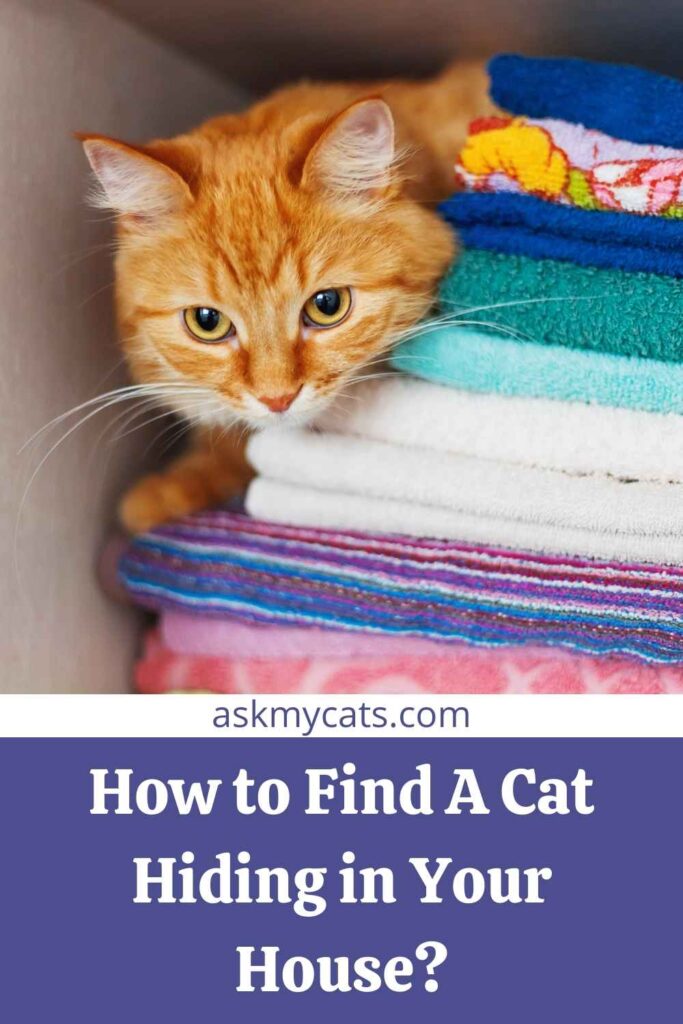When cats go missing, it’s usually because they’ve gone into hiding. The lost cat was discovered lurking directly inside the owner’s home in a few situations!
If you’ve recently adopted a new cat, one of the first things you should do is keep an eye out for it lurking in the house.
Cats have a capacity for slipping into the most inconvenient hiding spots—openings and corners you’d never think to look in. Searching your cat in those positions is your way to success.
While there are several things you should do right away if your cat goes missing, you should first try these measures to locate your lost pet if he’s hiding right under your nose.


Give Your Cat the Perfect Day
Get the Free Ebook!
Why Do Cats Hide In The House?
When there’s anything or someone nearby that makes your cat nervous, they’ll hide.

They may be scared or apprehensive of anything new and wish to get out of the way just in case. Another important motivation for a cat to conceal is its natural desire to be self-sufficient.
Hide and seek is a popular feline habit. Cats have an urge to defend themselves from predators, and being enclosed in a small, tight-fitting enclosure provides them with a sense of security. In the same way that cats prefer to cuddle up close to you all the time, cats sometimes hide because they’re looking for warmth.
You’re also aware of how a cat’s senses are acute. The sights and noises around them might quickly overwhelm them, especially if there are many people or dogs in the house. They can relax from too much stimulation by hiding in a secure spot.
Another reason you may be unable to locate your cat is that cats prefer to hide in a location that provides them with an excellent viewpoint for studying their surroundings. It may be part of their natural hunting instincts.
Cats hide for a variety of reasons, according to PLOS ONE, the most prevalent of which is behavioural stress.
Even a well-behaved cat could prefer to stay nestled beneath your porch if:
- Feeling trapped indoors
- Overwhelmed by the wide-open space of your home or yard
- Scared of strangers in the house
- New in the home and yet to acclimatize
- Sick or injured
- Expanding its territory
- Hiding from predators
According to the National Council of Science and Technology, cognitive failure in senior cats is another cause for a cat to hide. As cats get older, they often become disoriented, confused, and senile.
As their senses deteriorate, this might lead to behavioural abnormalities. During their golden years, old cats like to seek alone and hide.
New Cat Hiding In The House
A new cat will be shy and hiding in the house because he is not comfortable with the other house members.
The cat is still convinced that there is a threat. When confronted with that alleged fact, cats choose to hiss, bite, and scratch rather than emerge from their hiding place. You’ll need to reassure the cat that it’s safe in this situation.
If everything else fails, you may have to resort to force. Although it is not suggested, there are instances when leaving the cat outside alone, especially for lengthy periods, is more harmful. If you can’t reach the cat, such as when it’s up in a tree, you’ll need assistance.
You can call a veterinarian or even animal control. If the cat is within reach, such as beneath a bush or on a deck, you should intervene.
Of course, food and special treats are the quickest approaches to lure a hidden cat. Choose foods your cat likes, such as fish, meats, and luscious gravies, that are safe for cats.
However, if the cat isn’t hungry, using bait may not be effective. If this is the case, catnip is a good option.
Catnip is a minty, scented plant that has piqued the interest of felines on several occasions. Natural compounds in the plants appear to activate joyful neurotransmitters.
Cats get elated and hyperactive as a result of this. Catnip has even been shown to alleviate stress and enhance behaviour in cats when administered carefully.
Is It Normal For A Cat To Hide In A New Home?
Yes, it is normal for a cat to hide in a new home.
The hide is a healthy and perfectly typical behaviour for a cat in a new or unfamiliar setting. They were on familiar territory when you met your new pet at the shelter.
They most likely lived in the shelter with a family of other cats and were familiar with the faces of the shelter employees who supplied food and attention. They had returned “home.” They knew they were safe, and they had a variety of hiding spots in case they felt attacked.
How to Find A Cat Hiding in Your House?
The most effective way to get a cat out of hiding is with food. Choose food that has a strong odour and scent, such as tuna, wet cat food, or other meats.

If that doesn’t work, catnip is enticing, and it may even make the cat calmer while you recover it. If the cat cannot scent the bait, use the sound and appearance of toys to entice it. Using a laser pointer or a feather on a string will motivate the cat to hunt rather than hide.
If you have a new cat in the house, it may need to spend some time hiding to adjust to its new surroundings. Depending on its age, it may go into hiding for two to three days.
Allowing it to hide indoors will assist it in transitioning without placing it in danger by forcing it to hide outside.
A bonding room is the first step. The space should be quiet, with lots of cat toys, a litter box, and food and drink available at all times. If the cat still manages to escape into the big outside, use food, catnip, or a safer hiding area, such as a box filled with treats, to entice it back in.
When cats are terrified, agitated, or unsure about their surroundings, they retreat into hiding. This is appropriate behaviour indoors, and cats will come out when they’re ready. However, this might be an issue if your cat is lurking outside.
Your cat will be exposed to inclement weather, predators, and other dangers that might endanger its life. You’ll have to coax the cat out of hiding and into your haven.
Cats need to hide from time to time for their protection and comfort. In this situation, by offering an obvious escape path, you can coax the cat indoors, where it can hide safely.
Setting up a box with food and water near the cat’s hiding area might also assist the cat transfer to a safer location.
If everything else fails, you may need to force the cat out of its hiding place or ask for assistance. A veterinarian, the fire department, or even animal control may be able to help you rescue your cat.
How Long Can A Cat Hide In The House?
Your cat will hide until it feels secure again if it is terrifying.

The cat will determine the length of time it takes, what terrifies it, and how at ease it is in its surroundings. Here are a few examples of frequent scenarios:
A gently frightened cat, such as a loud noise, can hide for up to an hour. A terrified cat may hide for 1-5 hours or until the frightening item disappears.
After getting shocked, a new cat to your house may hide for 1-2 days. If the cat was a stray, it might hide for up to seven days, especially if the new stimuli in your yard have upset it.
A disillusioned or bewildered cat may only stay in hiding for around two weeks. While this may appear to be an unreasonable amount of time, it isn’t a concern unless the cat is sick or wounded. When the cat is comfortable, it will come out.
Allow it to calm down and emerge when needed if it is generally an outdoor cat. Water and food should be kept handy.
Keep in mind that cats will often appear when you aren’t seeking to eat or drink. If the cat cannot locate food or water, it will remain in hiding for long.
Place your cat’s dishes near the hiding location if it stays hidden for longer than 2-3 hours. These will not only help the cat relax but will also prevent it from being dehydrated.
Strays will be more likely to return to your home once they’ve finished hiding if you do this. Otherwise, the cat will flee and return just when it feels like it.
However, if the cat is generally an indoor cat, you have a more serious problem. It will be unaccustomed to the big outdoors and more vulnerable to predators. Snakes, skunks, and even birds of prey have been known to prey on cats.
You don’t have the luxury of patience in this circumstance. You’ll need to pull your cat out of hiding as soon as possible and confine it to an indoor location where it can relax.
Cat Hiding Places In The House
Many cats like to hide in dark, warm, confined, and quiet places. Try one of these specific areas if you can’t find your cat:
- Inside cardboard boxes and shoeboxes
- In the corners of closets
- Under beds
- Behind floor-length curtains
- Inside the box spring of a bed
- In the bathroom sink
- Behind warm appliances like the dryer or refrigerator
- Behind or under furniture
- Inside empty grocery bags
- Inside suitcases, backpacks, and briefcases
- Under potted plants or your Christmas tree
- Under shrubs or low trees in your yard
- Under a deck or porch
Frequently Asked Questions
Where do cats hide in the house when scared?
The main hiding place in your bedroom is beneath the bed. When cats are scared, you could discover them hiding behind sofas or chairs.
How do you find a lost cat?
A humane baited trap is often the most effective technique of capturing a missing cat. The sense of smell in cats is quite acute. If you’re using a baited trap (available at a feed shop or hardware store), line it with towels that smell like home to encourage her inside.
Where do cats hide inside the house?
They like to hide in confined locations like your closet, behind your bed, or in a cardboard box or paper bag that has been left on the floor. When your cat is hiding, it might take a long time and a good eye to discover her.
Final Words
Your search should be conducted calmly, deliberately, and methodically. If you’ve done everything and still can’t find your cat, take a break and give it some time.
He might be hiding out of fear, and the commotion generated by your search could have terrified him even more. If he doesn’t show up after an hour or two, you might opt to broaden your search to include the surrounding area.
Ask your questions in the comments section below.
